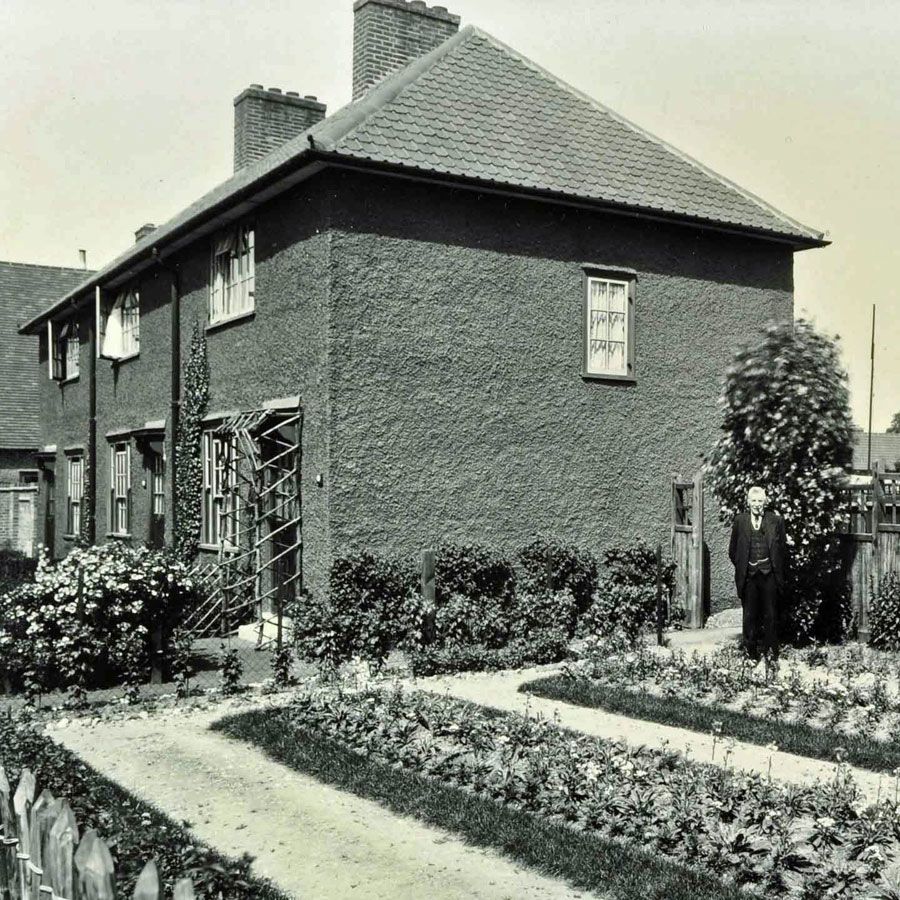The ups and downs of high-rise living
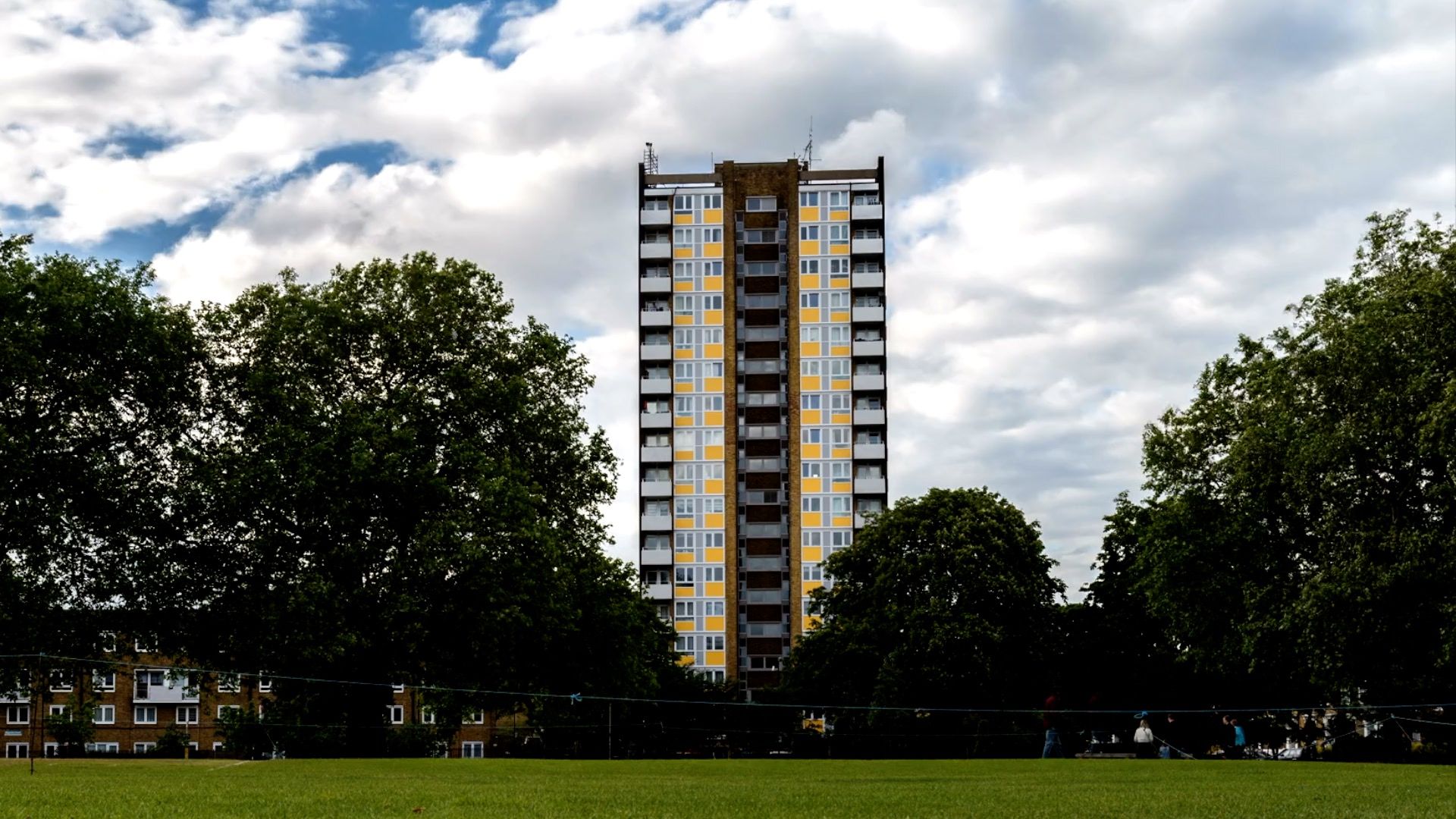
Raspberry-coloured walls, chocolate brown carpet, the murmur of a radio. A few paces into Jane Hall's flat you spy a drinks cabinet housing treasures from holidays past - melon liqueur, Grand Marnier and Shamrock Irish County Cream. Then coming into the lounge you are overwhelmed by sky. She lives on the 14th floor of Austin House, a tower block in Walsall and her lounge is a window on the world. Or the West Midlands at any rate.
Hall, currently getting around on crutches after a hip operation, feels very much at home.
“I love living on the 14th floor,” she says, standing on the balcony, pointing out local landmarks. “Over there you've got Sutton, Cannock and Lichfield. I'm originally a Birmingham girl and people say Walsall is urban but when you look out there's so much trees, foliage and green.”

Jane Hall on the balcony of her 14th floor flat
Jane Hall on the balcony of her 14th floor flat
She lives here with her ex-partner Dave and their dog Todd Bentley, named after a Canadian evangelist who, as she puts it with a wry smile, “fell from grace”. She works four days a week at Asda and today has her young grandson Lewis with her. He's allowed on the balcony but only with an adult.
High-rise living has its own rituals and quirks. She has an app telling her when the lights of the International Space Station are passing overhead. She watches out for the giant Emirates A380s orbiting Birmingham International Airport. And she knows when West Brom are at home from the glow of the floodlights.
Up here there are no spiders, plenty of ladybirds (they live in the cladding) and she gets to watch regular firework displays.
“Every season your view will change. You go from the trees being lush, to brown to shedding,” she says. “Winter is amazing as you can see so much more. Every time I look out I see something different.”

Until 2015 she lived in a three-bedroom house. But she and her partner didn't need all that space and a month after deciding to give it up she was offered this flat in an over-55s block.
Hall has never seen high-rise as strange. Her parents were moved out of the Birmingham slums in Ladywood and she grew up in a new town near the airport. It was a seven-storey block and her family lived on the sixth floor. There was a sense of freedom, she recalls.
“There were play areas and we were next to a park so it was ideal. It was the early 1960s, it was a brand new block so you'd got new radiators, flooring, everything was completely different from the back-to-backs in Ladywood.”

Some of the data in this article is drawn from BBC Briefing, a mini-series of downloadable in-depth guides to the big issues in the news, with input from academics, researchers and journalists. It is the BBC's response to audiences demanding better explanation of the facts behind the headlines.
In the beginning there was no stigma associated with living in a social housing block. Not like now, Hall laughs. She imitates the sound of someone sounding nervous when she tells them she lives in high-rise. What floor, they ask her. “I say 14 and they go, 'Oh, I couldn't live in a high-rise.’”
She explains how they need to change their perception, how tower blocks like hers are clean, safe and the lifts don't smell.
She lives here with her ex-partner Dave and their dog Todd Bentley, named after a Canadian evangelist who, as she puts it with a wry smile, “fell from grace”. She works four days a week at Asda and today has her young grandson Lewis with her. He's allowed on the balcony but only with an adult.
High-rise living has its own rituals and quirks. She has an app telling her when the lights of the International Space Station are passing overhead. She watches out for the giant Emirates A380s orbiting Birmingham International Airport. And she knows when West Brom are at home from the glow of the floodlights.
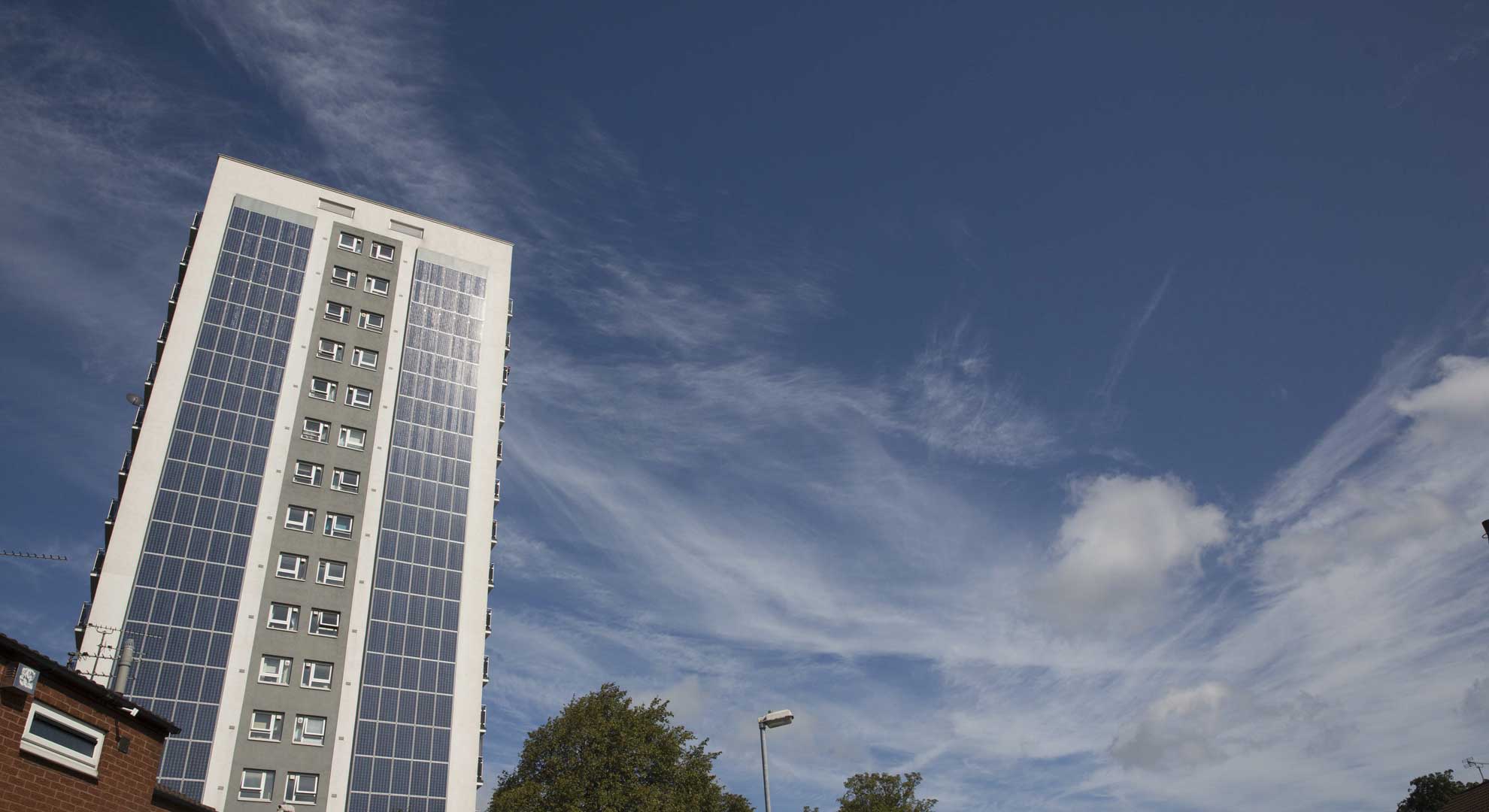
Up here there are no spiders, plenty of ladybirds - they live in the cladding - and she gets to watch regular firework displays.
“Every season your view will change. You go from the trees being lush, to brown to shedding,” she says. “Winter is amazing as you can see so much more. Every time I look out I see something different.”
Until 2015 she lived in a three-bedroom house. But she and her partner didn't need all that space and a month after deciding to give it up she was offered this flat in an over-55s block.
Hall has never seen high-rise as strange. Her parents were moved out of the Birmingham slums in Ladywood and she grew up in a new town near the airport. It was a seven-storey block and her family lived on the sixth floor. There was a sense of freedom, she recalls.

Some of the data in this article is drawn from BBC Briefing, a mini-series of downloadable in-depth guides to the big issues in the news, with input from academics, researchers and journalists. It is the BBC's response to audiences demanding better explanation of the facts behind the headlines.
- Download BBC Briefing: Housing
- Bitesize: Six things you'll learn from the BBC Briefing
- Is it time to celebrate the beauty of brutalism?
- House price calculator: Where can I afford to rent or buy?
“There were play areas and we were next to a park so it was ideal. It was the early 1960s, it was a brand new block so you'd got new radiators, flooring, everything was completely different than the back-to-backs in Ladywood.”
In the beginning there was no stigma associated with living in a social housing block. Not like now, Hall laughs. She imitates the sound of someone sounding nervous when she tells them she lives in a high-rise. What floor, they ask her. “I say 14 and they go, 'Oh, I couldn't live in a high-rise.’”
She explains how they need to change their perception, how tower blocks like hers are clean, safe and the lifts don't smell.
The high-rise dream

That people would choose to live in a concrete tower block might strike some as bizarre. And yet at their inception they were hailed as an escape from the slum housing of post-war Britain.
The first residential tower block was finished in 1951 as part of Harlow New Town in Essex. It was only 10 storeys high, but it was a radical departure from what had gone before. It was awarded a Ministry of Health Housing medal. Living high was synonymous with fresh air, light and modern appliances.
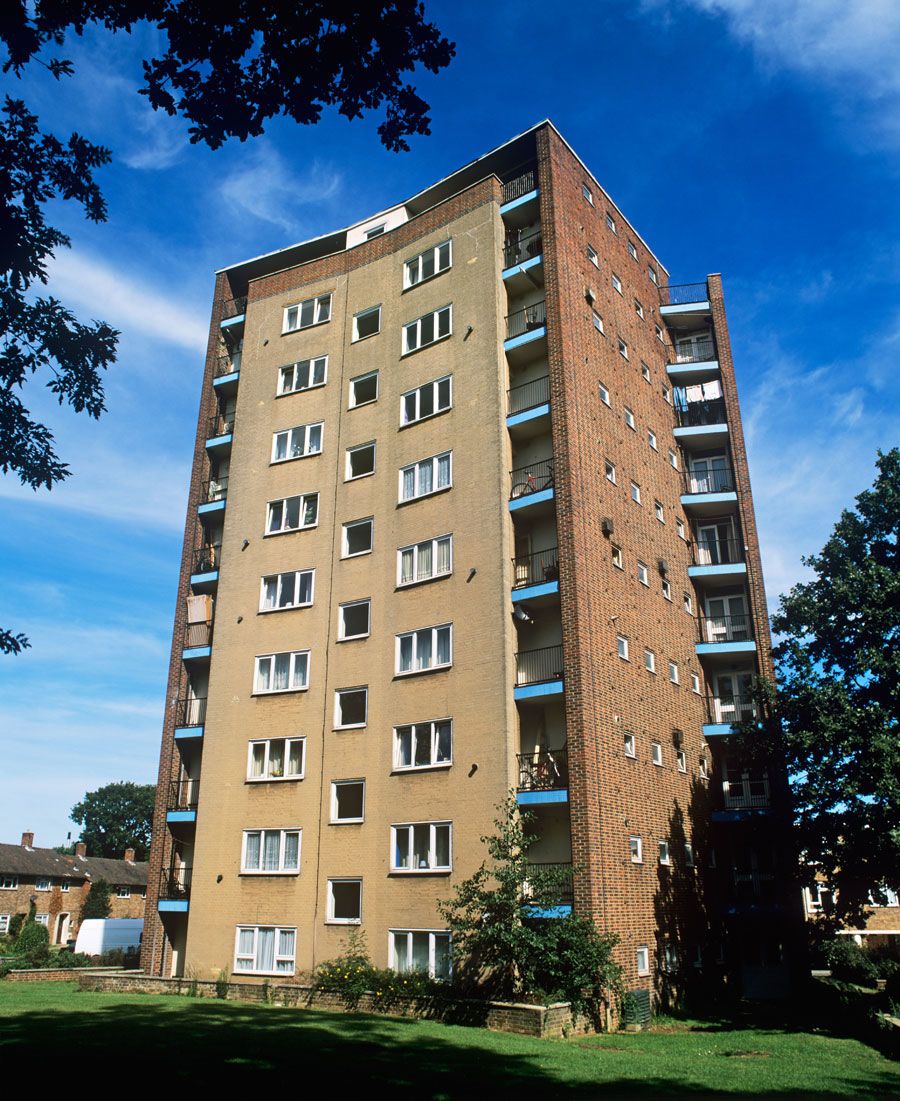
The Lawn in Harlow, Essex - the UK's first residential tower block
The Lawn in Harlow, Essex - the UK's first residential tower block
The architecture profession, politicians - of all stripes - and much of the media were mostly in favour. Building tall was the future.
High rise was an economical way of tackling the terrible legacy of slum housing in the UK. “We are going to win this battle,” declared the Conservative housing minister Henry Brooke in 1957. “I am determined to get all slums down.”

Construction at Moss Heights in Glasgow, 1953
Construction at Moss Heights in Glasgow, 1953
British architects in the 1950s looked not to the US but to the French architect Le Corbusier, who favoured raw concrete - in French, “beton brut”, hence the architectural term Brutalist. It would divide people into camps - architects often hailed these new forms as strikingly modern, but more traditionally minded citizens tended to see them as bleak and impersonal.
David Kynaston's social history, Modernity Britain: Opening The Box 1957-1959, captures the range of views towards high rise at the time. In 1957, the local government correspondent of the Manchester Guardian wrote: “There are, of course, social objections to compelling families with young children to live in high flats, and economic objections to a form of housing that costs over twice as much, in labour and materials, both to build and to maintain, as the two-storey dwelling which the vast majority of tenants prefer.”
However, many occupants were wowed by the modern facilities. Joan Dutton, who moved into a 10-storey block in Liverpool, told her local paper: “It takes some getting used to at first but once you've convinced yourself you are not dreaming, it is like being on a permanent holiday. The central heating scheme is marvellous. We really wanted a house, but until we came here we didn't know how comfortable a flat could be.”

1953: Inside a high rise flat on the Ackroydon estate, south London
1953: Inside a high rise flat on the Ackroydon estate, south London
Until the late 1950s, there had been a policy of dispersal - moving people out of the inner city slums to towns like Swindon and Watford. But as the 1960s approached the new urbanism proposed keeping people in the city and building at heights of 20 storeys or more.
In April 1958 the foundation stone for the Park Hill estate in Sheffield was laid. Built on a hill overlooking the city centre, it was the first “streets in the sky” development in Britain, a vast series of blocks housing more than 2,000 people. “Out of ugliness we are to create something of beauty and utility,” the lord mayor declared.
By the 1960s Britain was in the grip of a high-rise boom. The baton of tallest residential building passed from one new building to the next.
By 1975 a total of 440,000 high-rise flats for public housing had been created in the UK. It was fuelled by a government subsidy that increased with every extra storey. One of the structures built to this formula was the 24-storey Grenfell Tower in West London, which was completed in 1974.
But worries were creeping in. In 1968, while surveying high-rise tenants in Glasgow, the social researcher Pearl Jephcott flagged up concerns. “Practically no one disputes that this form of home [the high-rise] is unsatisfactory for the family with small children," she wrote.
And in the same year, a gas explosion caused Ronan Point, a new block in East London, to partially collapse, killing four people. The accident was caused by faulty construction, but even well-built towers had an Achilles heel - maintenance. It cost far more to put scaffolding up on a 20-storey block than a terraced house, but not enough money was generally put aside for the purpose.
When Margaret Thatcher's government came to power in 1979 the direction of travel in housing changed. Instead of building social housing, councils were told to sell their homes.

An explosion caused Ronan Point to partially collapse in 1968
An explosion caused Ronan Point to partially collapse in 1968
Increasingly, high-rise became associated with crime and a lack of community - from "streets in the sky" to "slums in the sky". Tower blocks gained an image problem that never completely went away.
High-rise became a convenient metaphor for society’s ills. In 1971, Stanley Kubrick's film Clockwork Orange was released, a vision of bleak, savage urban dystopia played out against the backdrop of the Thamesmead estate in south-east London.
Above: A block of flats being demolished on Hackney's Nightingale Estate, 2000
With the notable exception of the Barbican in central London, high-rise was not seen for many years as somewhere for the middle classes. It was mass housing for the poor.
Ever-rising house prices brought about a change of attitude in the 21st Century. There was also a growing appreciation for concrete towers, especially if they were built by signature architects such as Erno Goldfinger. His Trellick Tower in west London was Grade-II-listed in 1998 and a significant number of the flats are now privately owned.

Balfron Tower, east London
Balfron Tower, east London
More revealing still is what is happening at The Trellick’s “sister”, the Balfron Tower in Poplar, east London. Housing association tenants have been “decanted” out to lower-rise homes in the area, and the block is in the hands of a private developer, nearing the end of a multi-million pound refurbishment.
The flats, with their breathtaking views of central London, will soon be occupied by bankers, lawyers and other well-to-do professionals with a penchant for gritty urban design and three quarters of a million pounds or so to spare.
But for social housing tenants and private owners alike, a shadow was cast over high-rise living by the 2017 Grenfell Tower fire in west London, which killed 72 people. Its impact is still being felt, both emotionally and financially.
Coming down

“You should get a rope.”
Dani Leitch and Mark Hughson are remembering what a friend told them recently. It was meant “half jokingly” but the more they thought about it the more it made sense. The couple live on the ninth floor of a Manchester block that post-Grenfell has been found to be a fire risk.
If the building was to go up in flames and the fire were to spread to the stairs, they would have no way out. Hence, their contemplation of extreme measures. The rope needn't be long, they say. They would tie it to the balcony and climb down one floor at a time, untying and retying as they go.
It's dusk and I'm looking at rain-lashed Manchester from their balcony.
Down below, tiny figures hurry past the stationary tail-lights on a dual carriageway. To our left, illuminated trams fly over Victorian mills and ahead, in the distance, looms the outrageous overhang of the Beetham Tower.
The scene resembles a Lowry painting crossed with Ridley Scott's Blade Runner. It was the view that convinced Hughson to buy the flat in 2015. A couple of years later he started going out with Leitch - they worked at the same pensions firm but in offices hundreds of miles apart. Soon she moved up from Surrey and into her partner's flat.
All seemed well at first. The fire at Grenfell Tower had happened before she moved in. But it was only later that the implications began to hit home, that a similar fire could happen in hundreds of flats across Britain, including their own.
They live in City Gate 2, one of three City Gate blocks in the Castlefield district of Manchester. The buildings have been found to have combustible cladding, and a lack of cavity barriers which would prevent fire spreading. The buildings' steel frameworks also appear to lack fire protection.
The buildings’ managing agents, whose surveyors identified these problems, say that the apartment blocks could not have complied with the Building Regulations at the time of construction – the developer, Bellway, denies this.
Until recently there was a waking watch - people on patrol wearing hi-vis jackets - costing £3,200 a week across the three buildings. It ended at Christmas after the installation of smoke alarms to vulnerable areas.
There are fire detectors in the communal areas but they do not sound to residents. In fact there is no common fire alarm in the building, only smoke alarms in people's flats. And there are no sprinklers.
The lack of a sounding fire alarm is not illegal, indeed many apartment blocks operate this system, but it may surprise people. Indeed Hughson and Leitch were under the impression there was a central alarm they would hear if a fire started.
However it is the lack of any way out other than one flight of stairs that most worries them.
“It scares the living hell out of me,” Leitch says. “If there was a fire on the eighth floor we've got to make our way down.” Hughson adds that in the event of a fire the official advice is to “close all your doors and stay put”.
“Which I don't want to do,” Leitch interrupts. “I want to get out. Sorry, I'm not going to wait for a fire engine to come. If there's a fire, I'm getting out.” (This is where the rope idea came in).

At Grenfell the London Fire Brigade told residents to stay in their flats rather than try to escape. As Sir Martin Moore-Bick wrote in the report of the inquiry's first phase: “The evidence taken as a whole strongly suggests that the 'stay put' concept had become an article of faith within the LFB so powerful that to depart from it was to all intents and purposes unthinkable.”
His report concluded that “more lives could have been saved” if the “stay put” advice had been jettisoned earlier.
Fear of a fire is not the couple’s only anxiety. Like many leaseholders in high-rises, they face the question, who is going to pay to make the buildings safe?

The City Gate development, Manchester
The City Gate development, Manchester
City Gate was developed by Bellway, the UK's fourth biggest housebuilder - a FTSE 250 company. One might assume that this company would be liable for any outstanding issues. But one would be wrong. The law states that developers are no longer liable six or 10 years (depending on legal complexities) after a building is completed.
“Buildings stay up in places for hundreds of years. You can't have a warranty that lasts 10 years,” Hughson says. “It's not a valid reason, it's like a get-out-of-jail-free card.”
While he and his partner hold Bellway responsible, they think the government should be doing more to help them.
Theresa May's government last year announced it would compensate private high-rise buildings where the cladding is aluminium composite material (ACM), as Grenfell's was.
However, like hundreds of blocks around the UK, most of the City Gate cladding is non-ACM, made up of timber and other materials. In short, government money won't help the residents. To fix the cladding and cavities will cost an estimated £8.2m. If the steelwork has to be redone as well, the final sum could be much higher.

The managing agent for the building is a firm called Rendall & Rittner. Like companies across the country, it is passing the costs of the building work and interim safety measures to leaseholders like Leitch and Hughson through their service charge. Currently £120 a month, it is expected to rise to £550 a month. Then, as the more expensive work comes on track, it will go up more steeply.
“It's about 28 grand a flat over two years,” Hughson says. His parents - who helped him buy the property - have taken over the lease. He and Leitch pay the service charge, but they can't afford it any longer. They have no choice but to find somewhere else to live. In effect they are being forced out of their home.
Bellway told the BBC: “The City Gate buildings were built between 2003 and 2005 and passed all required building regulation checks at the time of completion. Recently, the managing agent has made us aware of some potential issues regarding the site. Bellway takes these issues very seriously and so, at its own cost, has committed to instruct an independent expert to review the situation.”
Manchester City Council is also under the spotlight for giving the building the all clear. “The Council issued a building regulations completion certificate based on the appropriate national government guidance from the time of completion,” a spokesperson says. “However, this is not conclusive evidence of on-going compliance and is not an approval of the quality of work carried out.”
The statement continues: “It was, and remains, the responsibility of the person carrying out the work to comply with building regulations, and it is a matter for the contractor or designers to ensure materials were used and properly installed - and any defects should be rectified by them.”
A spokesperson for Rendall & Rittner said: “All of the cladding installed at City Gate is being replaced, some of which is ACM cladding. Due to the age of the building, the 10-year warranty has expired and the buildings insurance does not cover these defects.”
Up and up?
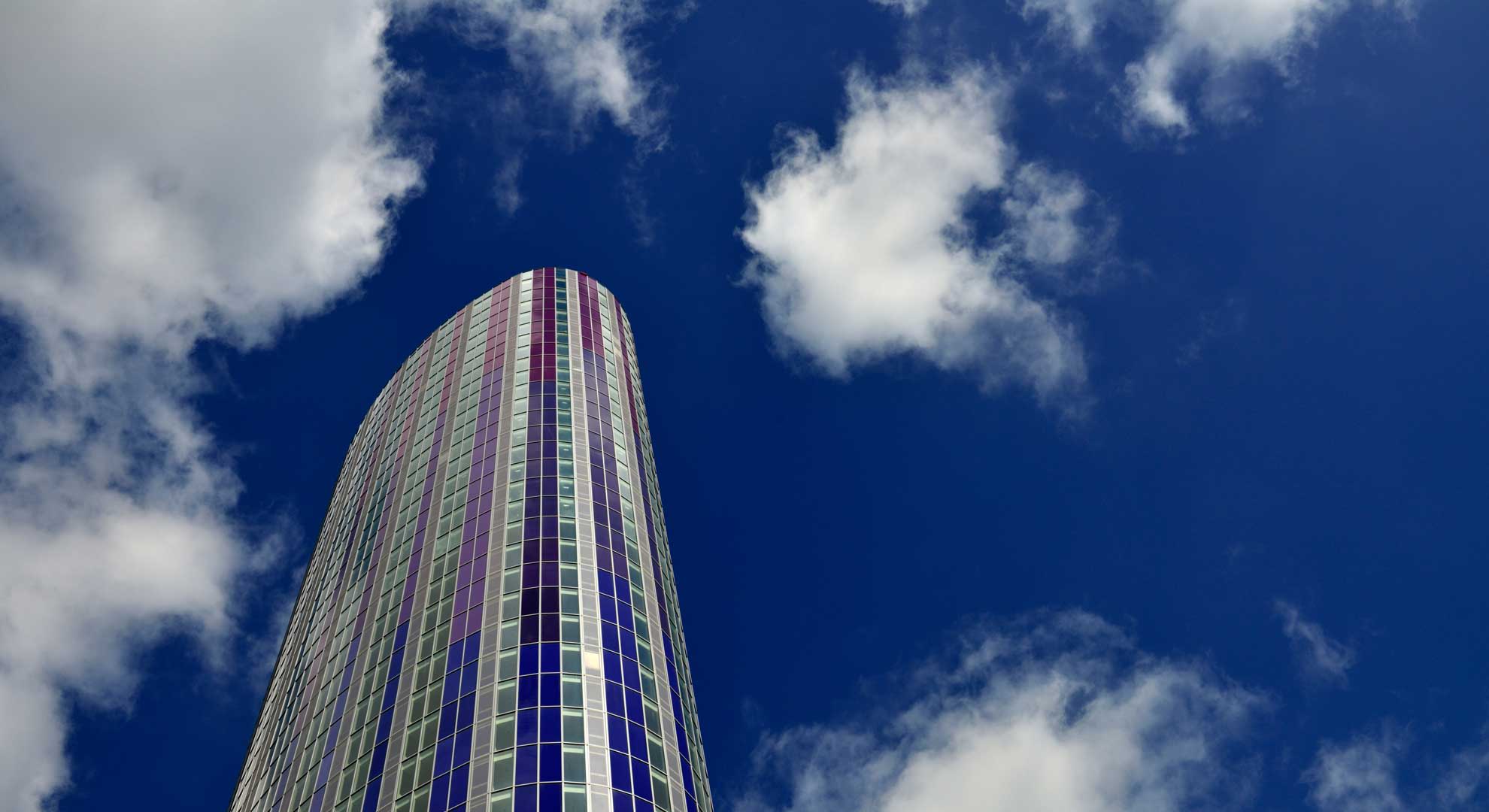
For the purposes of this article, one resident at the 43-storey Halo Tower in Stratford, east London, who lives on the 41st floor, volunteered to measure the time it takes to descend by stairs at normal pace. Answer: nine minutes, 45 seconds.
It’s a reminder that the lift is crucial to the smooth functioning of high-rise. Those towers that are popular with residents tend to have lifts that work.
No-one would live in a tall building if it took several minutes to climb up or down. In fact, the history of high-rise probably begins with the invention of the lift.
In 1842 Elisha Otis invented a safe elevator that would not plummet to the ground if the hoisting cable broke. It was this easy vertical transport from one floor to another that allowed the first skyscrapers to be built in Chicago and New York.

Elisha Otis demonstrates his new elevator in New York, 1853
Elisha Otis demonstrates his new elevator in New York, 1853
After the 2001 attack on the World Trade Center, there was widespread anxiety about tall buildings. For a time architects and planners hesitated. Were tall buildings too vulnerable to terror attacks? But as time went on, the panic dissipated. 9/11 was unique. Normal service was resumed.
A new term “super-tall skyscraper” had to be introduced for the growing number of buildings over 300m tall. There are now 21 buildings around the world more than 450m tall. Indeed, if the World Trade Center towers were still standing, they would be just 28th and 29th highest in the world.
If 9/11 failed to change the skyward direction of US buildings, it seems unlikely Grenfell will stop the growth of residential high-rise in the UK.
In 2020 the new towers tend to be private, made out of glass and steel rather than concrete and are called apartment buildings, not tower blocks.
Research from New London Architecture (NLA) last year suggested that there are 541 towers of more than 20 storeys planned or under construction in the capital, which, if built, will provide more than 110,000 new homes by 2030.

Peter Murray of NLA said at the time that the London skyline for the next 20 years will be “pockets of taller buildings located in those boroughs that are willing to accept them. These buildings are not super-tall, they are generally between 20 and 30 storeys.”
Even if some of these projects fall by the wayside it shows the dramatic shift upwards of UK housing. Horror over Grenfell remains but if these new homes are well-built, using high-quality materials in accordance with tighter safety legislation, many would argue there's no problem.
“We are facing a dire shortage of affordable housing in this country and high rises remain an important part of the solution,” says Victoria Moffett of the National Housing Federation, which represents social housing providers.
Meanwhile, house builders want to continue their skyward march. “As we look to build more desperately needed homes, land availability, especially in urban areas, dictates that high-rise living will play a significant part in how we build in the future,” says a spokesperson for the Home Builders Federation.
The HBF says that the number of flats being built as a proportion of the overall number of homes has dropped in recent years. Overall that may be so. But in big cities with high demand, like London and Manchester, the number of cranes on the horizon points to a different future.


Even if some of these projects fall by the wayside it shows the dramatic shift upwards of UK housing. Horror over Grenfell remains but if these new homes are well-built, using high quality materials in accordance with tighter safety legislation, many would argue there's no problem.
“We are facing a dire shortage of affordable housing in this country and high rises remain an important part of the solution,” says Victoria Moffett of the National Housing Federation, which represents social housing providers.
Meanwhile, house builders want to continue their skyward march. “As we look to build more desperately needed homes, land availability, especially in urban areas, dictates that high-rise living will play a significant part in how we build in the future,” says a spokesperson for the Home Builders Federation.
The HBF says that the number of flats being built as a proportion of the overall number of homes has dropped in recent years. Overall that may be so. But in big cities with high demand, like London and Manchester, the number of cranes on the horizon points to a different future.

Emporis, a data firm specialising in property, defines high-rise as anything between 35m and 100m. And it is in this area that a large number of buildings in particular hubs such as London and Manchester are emerging.
Grenfell may lead to tighter regulation. Since the fire the government has termed anything over 18m as high-rise. New legislation on sprinklers and cladding is expected.
But for Leitch and Hughson it feels like a grim future. Living at height has meant abandoning control of their environment to forces beyond their control. Hughson, who loved the buzz of the city, will be giving that up for somewhere lower-rise, ideally with a garden.

He thinks it's unjust that housebuilders can ignore the mistakes they made in the past and be allowed to build ever higher. “I just think it's immoral,” he says. He notes that Bellway were one of the major beneficiaries of the government's Help To Buy scheme.
Leitch believes a maximum storey height should be put in place. Her mental health has suffered and she can't wait to move out. “It's stressful. I've actually gone to the doctors about it.”
Back in Walsall, Jane Hall is in a different position. She's a social housing tenant. Social housing providers such as councils and housing associations have responded more quickly to the job of replacing flammable cladding. It's true that some social housing tenants like those on part of Tottenham's Broadwater Farm estate, are being moved out as their homes have been found to be structurally flawed. But Hall says she is lucky. The cladding on Austin House, owned by WHG, a housing association, has been checked and found to be safe.

She recalls a fire alarm not long after Grenfell. “It was about ten past midnight. We were in bed. You go, ‘Oh, what's that?’ And then my neighbour knocked on the door to say, ‘Are you ready, shall we go?’” And down they went, 14 floors with her dog under her arm. The fire brigade had had reports of smoke but in the end found nothing.
Hall is reassured by such incidents rather than frightened. “I wouldn't want to move even after Grenfell. I feel safe,” she says. “There's still a lot of questions around Grenfell but it has raised awareness for landlords and tenants.”

